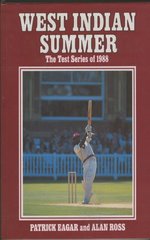West Indian Summer
David Taylor |Published: 1988
Pages: 112
Author: Ross, Alan and Eagar, Patrick
Publisher: Hodder and Stoughton
Rating: 3.5 stars

The name of Alan Ross was mentioned in these parts only last week. The poet and cricket writer, who died in 2001, wrote better books than this one, in all honesty, but here he is the lesser half of a double act. The acclaimed cricket photographer Patrick Eagar, son of Desmond, a Hampshire captain of the 1950s, gets the first name credit and the larger photograph on the inside of the dust jacket. The differentiation is appropriate, for this is largely a pictorial account of the England – West Indies series of 1988, which the tourists won 4-0 after losing the one-day series 3-0 and being held to a draw in the first Test.
The West Indies tourists of ’88 do not seem to be recalled with the same awestruck tones as their predecessors of 1976 and 1984, although they were actually more successful than Clive Lloyd’s first team, which drew the first two Tests of the series. Perhaps after being on the wrong end of successive “blackwashes” the English cricket fan was expecting to see his side lose anyway, and by the end of the summer was disappointed but not particularly surprised. In addition, as this is remembered as “the summer of four captains” the emphasis over the years has been on England’s travails rather than the tourists’ dominance. It seems that everything started to unravel for England once Mike Gatting had been replaced as captain after an indiscretion with a hotel barmaid. I’ve never tried to dig deep into that particular episode, and I wasn’t much better informed after reading Ross’s account of it here, a single page of which half is taken up with copies of newspaper cuttings. But the successive appointments of John Emburey, himself none too sure of his place for the second Test, Kent’s Chris Cowdrey (“a disastrous gamble” says Ross) for the fourth and Graham Gooch for the fifth tells its own story.
The book deals entirely with the international fixtures played that season – no mention is made of the other eleven first-class matches played by the visitors, and in any case I doubt if Eagar would have followed them all around the country. There is a match report for each game by Ross, accompanied by several pages of photographs – and, in the centre, 16 pages of colour photographs. This was, in 1988, a bigger deal than it sounds today – Wisden only started using colour pictures the same year, and I note from perusing other books from the mid-1980s that black and white photos were the rule rather than the exception. Anyone who is familiar with Patrick Eagar’s work will not be surprised to hear that the photography (“yes, one does watch every ball, but no, one doesn’t photograph every ball” he states in his introduction – the answer, no doubt, to a much-asked question) is superb throughout. The captions, written I assume by Eagar, range from the observant and technically informative to the whimsical. Ross does an efficient job with his match reports but they are a little score-heavy for my liking; the pictures are the stars of this book. There are a number of English batsmen evading fast deliveries, and of West Indian fast bowlers celebrating wickets, with much high-fiving – the story of the summer, indeed. For now, at least, the boot is very much on the other foot. As for the rating, I would not claim that this is an indispensable addition to any cricket library; I have awarded 2.5 for the text, 4.5 for the pictures, and taken an average.






Leave a comment